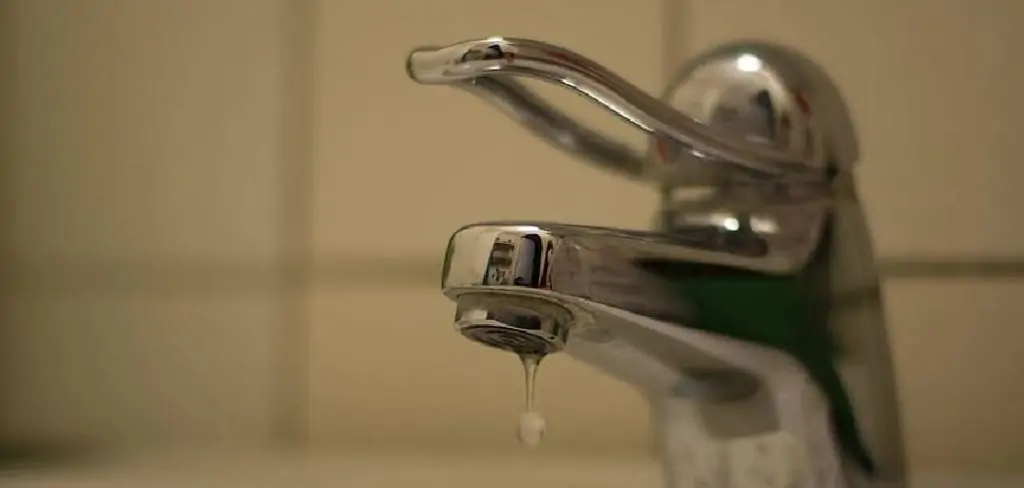Tightening a loose faucet handle is a simple task that can be done without any professional help. It’s an essential maintenance step to ensure your faucet works correctly and doesn’t leak water. A loose handle not only causes inconvenience, but it can also lead to water wastage and damage the faucet over time.
In this guide, we will discuss how to tighten a loose faucet handle in easy steps.

How to Identify the Cause of a Loose Faucet Handle
Before we jump into tightening the faucet handle, it’s crucial to identify the cause of the looseness. This will help in determining the best course of action and prevent the handle from becoming loose again in the future.
One common reason for a loose faucet handle is worn-out screws or bolts that hold it in place. In this case, simply replacing these parts with new ones can solve the issue.
Another possible cause could be a worn-out or damaged cartridge or stem inside the faucet. This is usually seen in older faucets and may require professional assistance to fix.
Tools Required
To tighten a loose faucet handle, you will need the following tools:
- Screwdriver (depending on the type of faucet)
- Allen key (if required)
- Adjustable wrench
10 Steps on How to Tighten a Loose Faucet Handle
Dealing with a loose faucet handle can be a real nuisance. The constant wobbling and rattling not only make your sink area look shabby but also can be a sign of more significant internal issues with your faucet. Luckily, tightening a loose handle is often easier than it seems, and by following these ten steps, you can skip the plumber’s bill and enjoy the satisfaction of a job well done.

1. Switch Off the Water
Safety should always come first when dealing with plumbing. Start by turning off the water supply to your faucet. There’s usually a shut-off valve beneath the sink. If your faucet doesn’t have its own valve, you may need to turn off the main water supply to your home.
2. Gather the Right Tools
Equipping yourself with the proper tools will make the job much more straightforward. You’ll need an adjustable wrench, a screwdriver set, and possibly some plumber’s tape. Ensure that the wrench fits the nuts and bolts of your specific faucet model.
3. Identify the Faucet Type
Each faucet design is different, and so is the method for tightening its handle. Is it a cartridge, ball, ceramic-disk, or a compression faucet? Understanding which type you have will help you find the right approach for tightening the handle and prevent any potential damage.
4. Remove the Handle Cap
Most faucet handles have a decorative cap covering the screw that attaches the handle to the stem or cartridge. Use a small flat-head screwdriver or a similarly sized tool to pop off the cap gently. Be sure to do this carefully to avoid damaging the cap or handle.

5. Tighten the Handle Screw
Once the screw is exposed, use your screwdriver to tighten it. Turn it clockwise to secure the handle firmly onto the stem or cartridge. Do not over-tighten, as this can strip the threads or cause the screw to break. A snug fit is all you need.
6. Inspect for Corrosion
While the screw is out, look for any signs of corrosion in the vicinity. This could be a buildup of mineral deposits or actual rust. If you spot any, clean the area with a mixture of vinegar and water to help prevent the issue from recurring.
7. Reassemble the Handle
With the screw tightened and any corrosion dealt with, place the handle cap back onto the handle assembly. Press it into place firmly but gently. If the cap is difficult to reattach, investigate further for underlying issues, such as stripped threads or a damaged handle.
8. Turn the Water Back On
After reassembling the handle, turn the water supply back on. Slowly open the faucet to check for leaks. If the handle is still loose, you may need to disassemble it again and inspect the internal components more thoroughly.

9. Apply Plumber’s Tape (if necessary)
In certain cases, especially if the handle continues to leak or if it’s a compression faucet, applying plumber’s tape can help create a better seal. Wrap the tape around the stem threads before reattaching the handle to reduce the likelihood of leaks.
10. Monitor for Issues
After tightening the handle, keep an eye on your faucet for a few days to make sure everything is working as it should. If you notice any leaks, adjust and re-tighten the handle as necessary or seek professional help to address any deeper issues.
By following these steps, you can usually resolve a loose faucet handle on your own. Remember always to exercise caution, and if the problem persists or worsens, don’t hesitate to call a licensed plumber.
5 Common Mistake Tightening a Loose Faucet Handle
While it’s essential to know how to tighten a loose faucet handle, it’s even better to prevent them from happening in the first place. Here are some common mistake you can avoid doing to keep your faucet handles tight and functioning correctly:
- Over-tightening the handle screw: As mentioned earlier, over-tightening can damage your faucet’s internal components and cause leaks. Always use caution and tighten the screws just enough to secure the handle in place.
- Using incorrect tools: Every faucet is unique, and using the wrong tools can lead to stripped threads or damaged parts. Make sure you have the proper tools before attempting to tighten your faucet handle.
- Neglecting corrosion: A little bit of white vinegar can go a long way in preventing future issues with your faucet. Don’t ignore signs of corrosion and take preventative measures to avoid costly repairs down the road.
- Not turning off the water supply: Trying to tighten a loose faucet handle while the water is still running can result in a messy and potentially dangerous situation. Always turn off the water supply before working on your faucet.
- Ignoring underlying issues: A loose handle may seem like a minor inconvenience, but it could be a sign of more significant problems with your faucet’s internal components. If you keep experiencing loose handles, seek professional help to address any underlying issues before they escalate.
By being aware of these common mistakes, you can prolong the life of your faucet and avoid unnecessary repairs or replacements. Regular maintenance and proper handling can go a long way in keeping your faucet handle tight and your sink area looking clean and functional. So next time you encounter a loose handle, follow these steps, avoid these mistakes, and enjoy the satisfaction of fixing the problem yourself.

Frequently Asked Questions
Why is My Faucet Handle Loose?
The faucet stands as an unsung hero in the households of our daily lives, dutifully providing water with a simple twist. But what happens when that twist begets a wobble, and the trusty handle begins to gyrate with unsettling freedom? “Why is my faucet handle loose?” you ask in mild alarm as it jiggles to and for under your grip. It’s more than an annoyance—it’s a siren call for maintenance, urging prompt action to avert the wearisome drip of a leak or the stark disruption of a broken fixture.
But fear not! The remedy is within your grasp. With the right tools and a few moments of your time, learning how to tighten a loose faucet handle can transform from a mysterious quandary to a conquered skill. With each careful turn of a wrench, you reaffirm your DIY prowess, ensuring the flow of water is regulated once more by a firm and secure handle, extending the life and integrity of this vital component of home life.
Can You Tighten a Faucet?
Yes, you can tighten a faucet handle! In fact, it’s a relatively simple task that can save you time and money in the long run by avoiding costly repairs or replacements. By following the steps outlined above, you can easily tighten your faucet handle and restore its stability and proper function. However, if the problem persists or worsens, it may be an indication of a more significant issue with your faucet’s internal components, and it may be best to call a professional plumber for assistance.
How Often Should You Tighten Your Faucet Handle?
There is no set timeframe for when you should tighten your faucet handle as it will depend on how often the faucet is used and the quality of its installation. Some experts recommend checking and tightening the handle at least once a year as part of regular maintenance. However, if you notice your faucet handle becoming loose more frequently, it may be a sign of underlying issues that need to be addressed. Regularly inspecting and maintaining your faucet can help prevent future problems and extend its lifespan. So don’t ignore a loose faucet handle and make sure to check on it periodically to keep it functioning properly.
Conclusion
A loose faucet handle may seem like a minor inconvenience, but if left unaddressed, it can lead to more significant problems and even costly repairs. Learning how to tighten a loose faucet handle is a valuable skill that can save you time, money, and frustration in the long run. By following the steps outlined in this guide and avoiding common mistakes, you can easily fix a loose handle yourself and keep your faucet functioning properly for years to come.
Remember to exercise caution, regularly maintain your faucet, and seek professional help if necessary. With these tips in mind, you can confidently tackle any loose faucet handle with ease. So next time you encounter one, don’t panic – just grab your tools and get to work! Keep your faucet handles tight and your sink area tidy and functional. Your future self will thank you.
